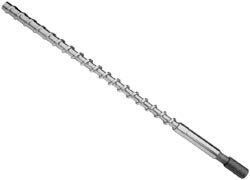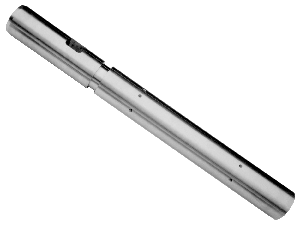|
Call Today 800-627-1033 |
|
|
|
|
||
|
|
||

It is very difficult to estimate the life expectancy of a feedscrew or barrel. Due to many variables effecting productivity, each barrel and feedscrew is unique. However, the primary cause of premature deterioration is excess wear; and wear causes problems that result in the loss of production yield.
There are three types of wear that can occur during the molding process:
Abrasion - Caused by the fillers or make up of the resin
Corrosive - Caused by the additives in the resin
Adhesive - Caused by excessive friction between the barrel and feedscrew
The most serious type of wear is adhesive. Although the feedscrew is intended to rotate freely in the barrel bore, under normal circumstances the feedscrew makes casual contact with the bore. If the contact becomes too great, adhesive wear occurs. There are a number of reasons that the contact between the feedscrew and barrel could increase, including;
Another cause of adhesive wear is using matched-steel components. For example, using a feedscrew and a barrel both manufactured from D-2 steel, and heat treated to the same value, will cause a high coefficient of friction, which in turn results in galling of the components.
Other factors that may cause adhesive wear include:

The person who purchases the new feedscrew and barrel is the one who has control over the life expectancy. If the unit is purchased based on price alone, and the components are not of the correct grade of steel for the application, the life will be greatly reduced.Or, if the feedscrew design is not close for the application or the cycle run, the life span can be reduced.
The individual installing the barrel and feedscrew also has some control of the life. During installation, steps must be taken to ensure the components are not chipped or scratched, or bolts are over tightened, etc. If used components are to be used with the new components, these should be inspected dimensionally for straightness.Many feedscrews that look good, but have been removed from worn barrels, are bent! Any time a new or rebuilt component is used in conjunction with a used or worn component, you should expect a shorter life span from your new component(s).
Many molding operations have a great number of people who have the authority to make changes to the molding cycle (time, temperature, pressures).One mistake can be the downfall of the life of your components.
This question can not be answered by simply measuring your barrel and feedscrew simply because some materials are more efficient than others when molding with worn components. You must measure your lost production yield. If you can not schedule around the wear, and you are losing production yield, it's time to add up the lost dollars.It's simple math.How much money are you losing in lost production yields versus the cost of a new unit?
If you schedule your molding machine properly, purchase quality components that match the requirements of your process, and stay within the other guidelines, your components should have a long and productive life.
![]()
Home | Request a Quote | Place an Order | Product Index | Online Catalog |
Barrels & feedscrews | Electrical Products | Hoses & Fittings |
Molding Accessories | SDS Sheets | Credit Application | Terms & Conditions | About Us | Contact Us
7925 N. Clinton St., Fort Wayne, IN 46825-3113, USA
E-mail: Sales@ServicesForPlastics.com
Contact Webmaster regarding content or link problems
Copyright 1997-2024 | Services For Plastics, Inc. | All rights reserved. | Privacy Policy